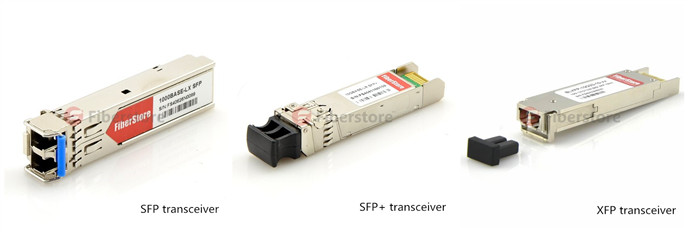Fiber optic transceiver including both transmitter and receiver in a single module is an important equipment transmitting and receiving data to support the normal operation of optical fiber data transmission system. The market currently offers a wide selection of fiber optic transceiver for use with different types of wire, fiber and wavelength and so on.
A group of companies joined together to agree on package standards also called multisource agreements (MSAs). The package standards help customers choose the best transceivers to their applications and make sure the they can use transceiver from multiple vendor without redesigning the board. In the following text, some common fiber optic transceivers according to package standards are introduced in details.

9-Pin transceiver is also known as 1×9 optical transceiver. This transceiver has a single row of output pins at the rear of the device. The optical interface is usually ST or duplex SC receptacles. It is mainly used in fiber optic transceiver, optical switches, single/multi-mode converter as well as some industrial control applications.
GBIC transceiver, namely gigabit interface converter transceiver, is a plug-in interface designed to allow a pluggable interface for Gigabit Ethernet. It offers a standard, hot swappable electrical interface and can support a wide range of physical media from copper to long-wave single mode optical fiber, at lengths of hundreds of kilometers. However, this type of transceiver is gradually replaced by SFP transceiver which has more advantages.
SFF (small form-factor) transceiver is a compact optical transceiver used in optical communications for both telecommunication and data communications applications. Compare to 9-pin and GBIC transceivers, SFF transceivers is smaller allowing more ports in a given area. SFF transceivers have 10 or 20 I/O (input/output) pins that solder to the board.
 SFP transceiver, small form-factor pluggable, small hot-pluggable optical module is a pluggable version of SFF transceiver and an upgraded version of the early GBIC module, with 10 I/O connections at the rear of the package. With smaller volume and higher integration, it is currently the most popular fiber optic transceiver.
SFP transceiver, small form-factor pluggable, small hot-pluggable optical module is a pluggable version of SFF transceiver and an upgraded version of the early GBIC module, with 10 I/O connections at the rear of the package. With smaller volume and higher integration, it is currently the most popular fiber optic transceiver.
SFP+ transceiver, also called enhanced SFP or SFP plus, with a higher transmission rate usually up to 8.5 G or 10 G, is a kind of optical transceiver module specified for 8Gbps/10Gbps/16Gbps fiber channel and 10Gigabit Ethernet applications.
XFP transceiver, 10Gigabit small form-factor pluggable transceiver, is the next generation SFP transceiver for 10Gbps application. This type of transceiver is hot-swappable and protocol-independent and is usually used to 10Gbps SONET/SDH, fiber channel, Gigabit Ethernet and other applications, but also of CWDM DWDM link.
 XENPAK transceiver is a pluggable transceiver for 10Gbps applications, specifically 10 Gigabit Ethernet. The electrical interface is called XAUI, which provides four 2.5Gbps signals to the transmitter, which multiplexes or serialize them into a single 10Gbps signal to drive the source. It uses a 70-pin electrical connector. The optical interface is usually a duplex SC.
XENPAK transceiver is a pluggable transceiver for 10Gbps applications, specifically 10 Gigabit Ethernet. The electrical interface is called XAUI, which provides four 2.5Gbps signals to the transmitter, which multiplexes or serialize them into a single 10Gbps signal to drive the source. It uses a 70-pin electrical connector. The optical interface is usually a duplex SC.
X2 transceiver is based on the XENPAK transceiver standards. It is shorter than XENPAK transceiver but uses same 70-position electrical and duplex SC interfaces. Unlike XENPAK, X2 devices mount on top of the board and are low enough to allow boards to be stacked side by side.
